Effective Strategies for Managing Supply Chain Uncertainties
VerifiedAdded on 2022/11/26
|12
|3520
|146
Report
AI Summary
This report delves into the multifaceted challenges of managing uncertainties within the supply chain. It begins by highlighting the critical role of the supply chain in connecting organizations with their customers and suppliers, emphasizing the need for effective risk management strategies. The report explores various types of uncertainties, including those stemming from natural disasters and human actions, stressing the importance of tailored approaches. It outlines key considerations for managing uncertainties, such as understanding the nature and recurrence of the risk, and the specific areas of the supply chain affected. Furthermore, the report discusses crucial points when seeking methods to manage uncertainties, including the legality, ethical considerations, and suitability of interventions. It concludes by posing essential questions for organizations to consider before implementing strategies, such as the availability of leadership, financial resources, and the likelihood of success of the selected strategies. The report emphasizes the need for proactive measures to mitigate risks and ensure the resilience of the supply chain.
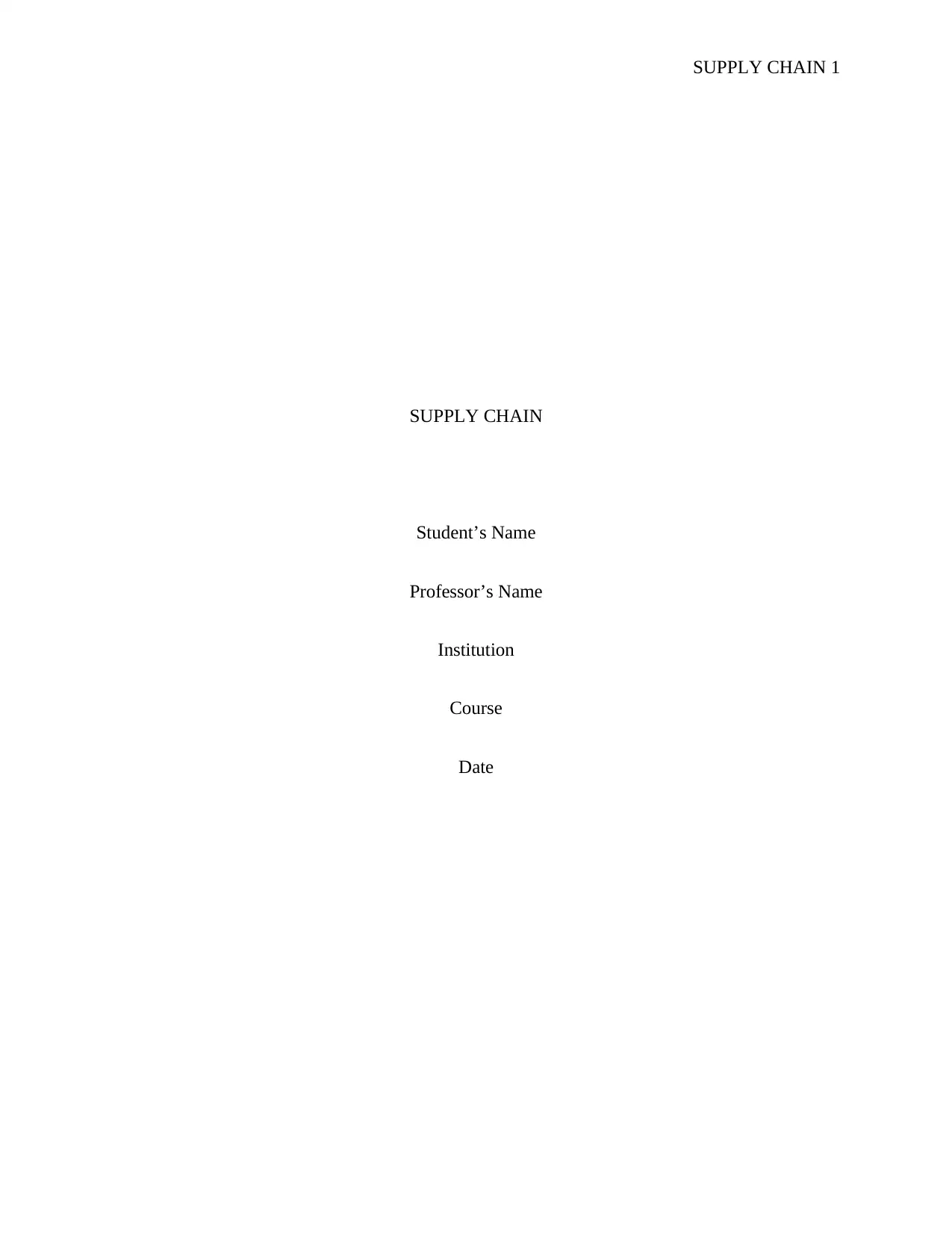
SUPPLY CHAIN 1
SUPPLY CHAIN
Student’s Name
Professor’s Name
Institution
Course
Date
SUPPLY CHAIN
Student’s Name
Professor’s Name
Institution
Course
Date
Paraphrase This Document
Need a fresh take? Get an instant paraphrase of this document with our AI Paraphraser
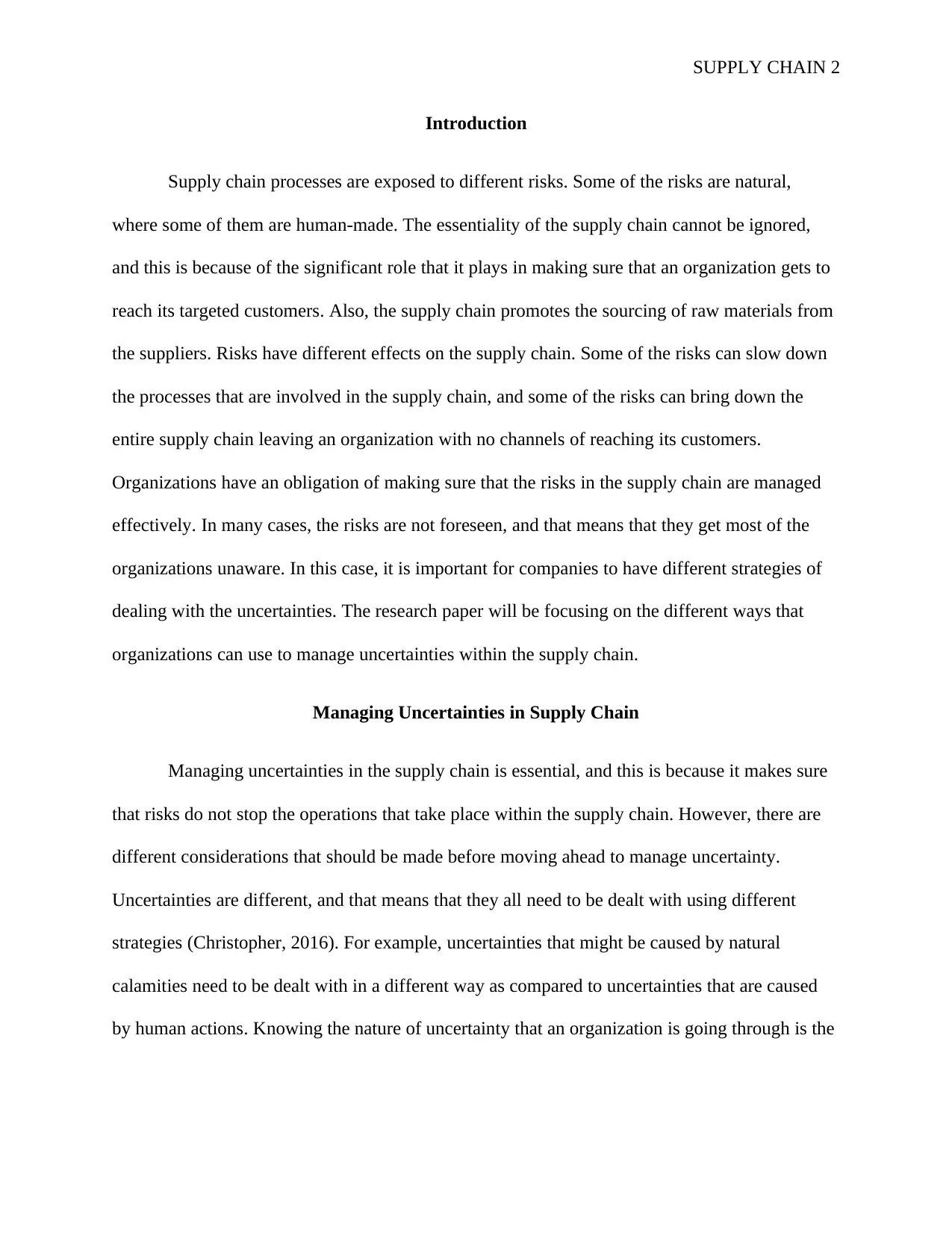
SUPPLY CHAIN 2
Introduction
Supply chain processes are exposed to different risks. Some of the risks are natural,
where some of them are human-made. The essentiality of the supply chain cannot be ignored,
and this is because of the significant role that it plays in making sure that an organization gets to
reach its targeted customers. Also, the supply chain promotes the sourcing of raw materials from
the suppliers. Risks have different effects on the supply chain. Some of the risks can slow down
the processes that are involved in the supply chain, and some of the risks can bring down the
entire supply chain leaving an organization with no channels of reaching its customers.
Organizations have an obligation of making sure that the risks in the supply chain are managed
effectively. In many cases, the risks are not foreseen, and that means that they get most of the
organizations unaware. In this case, it is important for companies to have different strategies of
dealing with the uncertainties. The research paper will be focusing on the different ways that
organizations can use to manage uncertainties within the supply chain.
Managing Uncertainties in Supply Chain
Managing uncertainties in the supply chain is essential, and this is because it makes sure
that risks do not stop the operations that take place within the supply chain. However, there are
different considerations that should be made before moving ahead to manage uncertainty.
Uncertainties are different, and that means that they all need to be dealt with using different
strategies (Christopher, 2016). For example, uncertainties that might be caused by natural
calamities need to be dealt with in a different way as compared to uncertainties that are caused
by human actions. Knowing the nature of uncertainty that an organization is going through is the
Introduction
Supply chain processes are exposed to different risks. Some of the risks are natural,
where some of them are human-made. The essentiality of the supply chain cannot be ignored,
and this is because of the significant role that it plays in making sure that an organization gets to
reach its targeted customers. Also, the supply chain promotes the sourcing of raw materials from
the suppliers. Risks have different effects on the supply chain. Some of the risks can slow down
the processes that are involved in the supply chain, and some of the risks can bring down the
entire supply chain leaving an organization with no channels of reaching its customers.
Organizations have an obligation of making sure that the risks in the supply chain are managed
effectively. In many cases, the risks are not foreseen, and that means that they get most of the
organizations unaware. In this case, it is important for companies to have different strategies of
dealing with the uncertainties. The research paper will be focusing on the different ways that
organizations can use to manage uncertainties within the supply chain.
Managing Uncertainties in Supply Chain
Managing uncertainties in the supply chain is essential, and this is because it makes sure
that risks do not stop the operations that take place within the supply chain. However, there are
different considerations that should be made before moving ahead to manage uncertainty.
Uncertainties are different, and that means that they all need to be dealt with using different
strategies (Christopher, 2016). For example, uncertainties that might be caused by natural
calamities need to be dealt with in a different way as compared to uncertainties that are caused
by human actions. Knowing the nature of uncertainty that an organization is going through is the
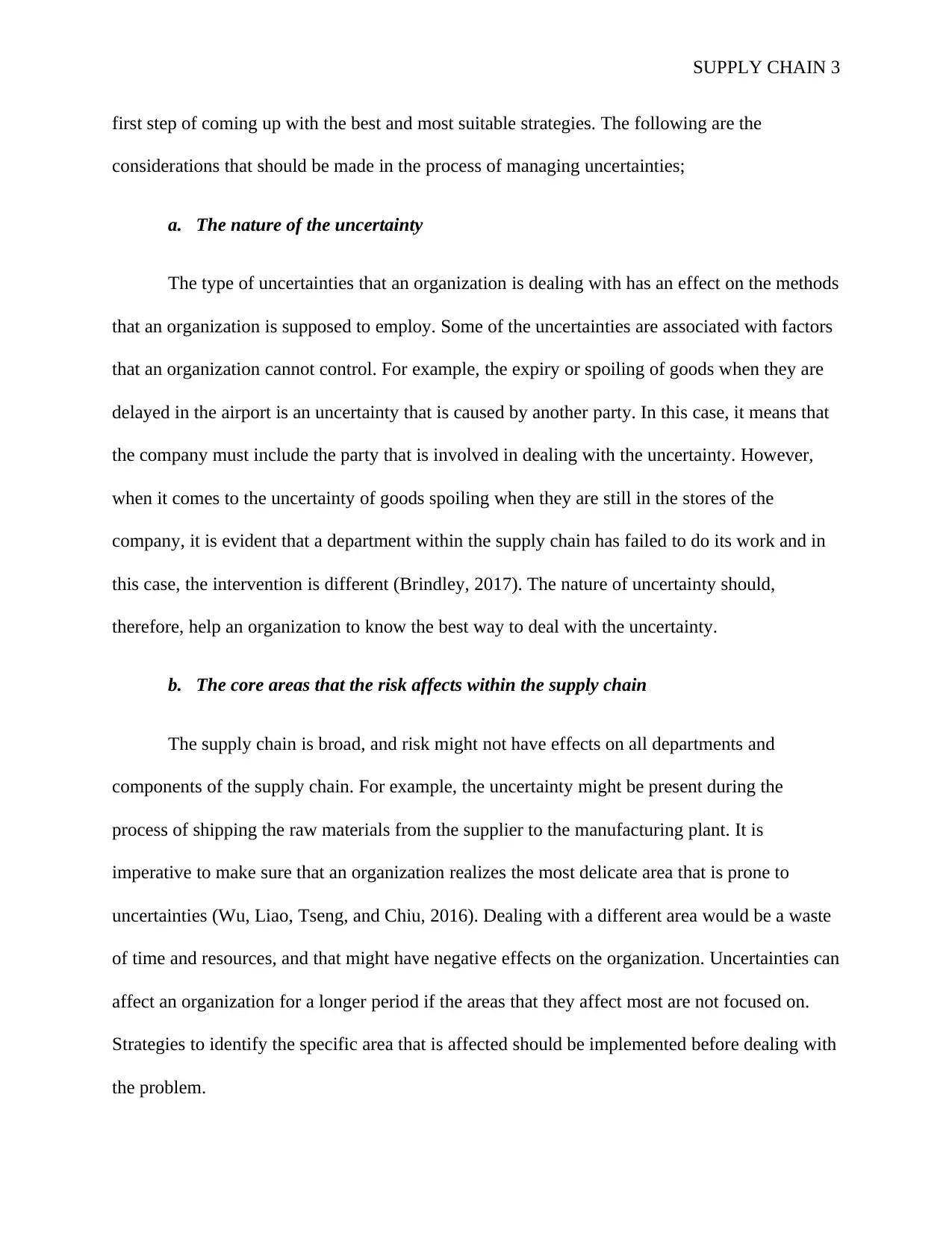
SUPPLY CHAIN 3
first step of coming up with the best and most suitable strategies. The following are the
considerations that should be made in the process of managing uncertainties;
a. The nature of the uncertainty
The type of uncertainties that an organization is dealing with has an effect on the methods
that an organization is supposed to employ. Some of the uncertainties are associated with factors
that an organization cannot control. For example, the expiry or spoiling of goods when they are
delayed in the airport is an uncertainty that is caused by another party. In this case, it means that
the company must include the party that is involved in dealing with the uncertainty. However,
when it comes to the uncertainty of goods spoiling when they are still in the stores of the
company, it is evident that a department within the supply chain has failed to do its work and in
this case, the intervention is different (Brindley, 2017). The nature of uncertainty should,
therefore, help an organization to know the best way to deal with the uncertainty.
b. The core areas that the risk affects within the supply chain
The supply chain is broad, and risk might not have effects on all departments and
components of the supply chain. For example, the uncertainty might be present during the
process of shipping the raw materials from the supplier to the manufacturing plant. It is
imperative to make sure that an organization realizes the most delicate area that is prone to
uncertainties (Wu, Liao, Tseng, and Chiu, 2016). Dealing with a different area would be a waste
of time and resources, and that might have negative effects on the organization. Uncertainties can
affect an organization for a longer period if the areas that they affect most are not focused on.
Strategies to identify the specific area that is affected should be implemented before dealing with
the problem.
first step of coming up with the best and most suitable strategies. The following are the
considerations that should be made in the process of managing uncertainties;
a. The nature of the uncertainty
The type of uncertainties that an organization is dealing with has an effect on the methods
that an organization is supposed to employ. Some of the uncertainties are associated with factors
that an organization cannot control. For example, the expiry or spoiling of goods when they are
delayed in the airport is an uncertainty that is caused by another party. In this case, it means that
the company must include the party that is involved in dealing with the uncertainty. However,
when it comes to the uncertainty of goods spoiling when they are still in the stores of the
company, it is evident that a department within the supply chain has failed to do its work and in
this case, the intervention is different (Brindley, 2017). The nature of uncertainty should,
therefore, help an organization to know the best way to deal with the uncertainty.
b. The core areas that the risk affects within the supply chain
The supply chain is broad, and risk might not have effects on all departments and
components of the supply chain. For example, the uncertainty might be present during the
process of shipping the raw materials from the supplier to the manufacturing plant. It is
imperative to make sure that an organization realizes the most delicate area that is prone to
uncertainties (Wu, Liao, Tseng, and Chiu, 2016). Dealing with a different area would be a waste
of time and resources, and that might have negative effects on the organization. Uncertainties can
affect an organization for a longer period if the areas that they affect most are not focused on.
Strategies to identify the specific area that is affected should be implemented before dealing with
the problem.
⊘ This is a preview!⊘
Do you want full access?
Subscribe today to unlock all pages.

Trusted by 1+ million students worldwide
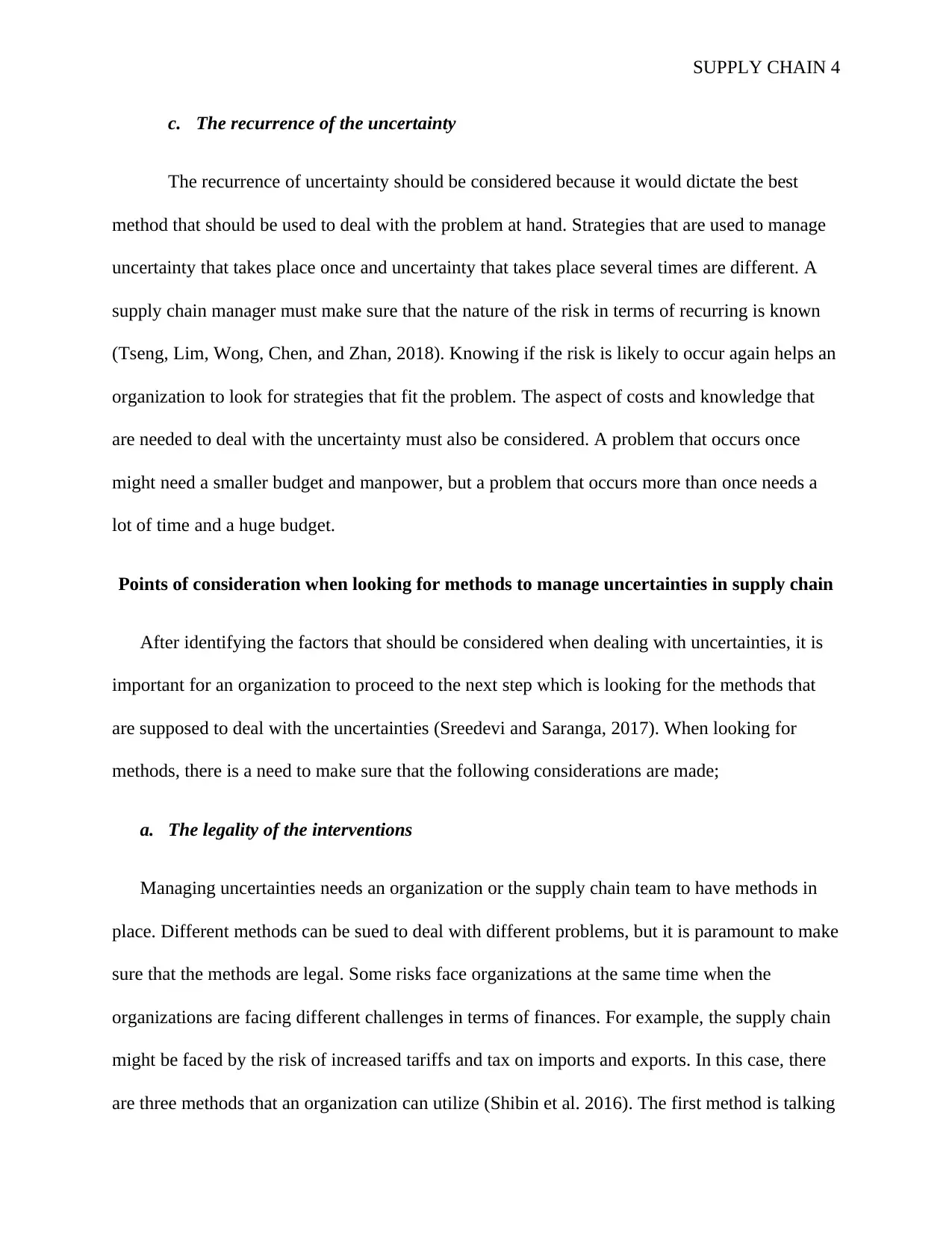
SUPPLY CHAIN 4
c. The recurrence of the uncertainty
The recurrence of uncertainty should be considered because it would dictate the best
method that should be used to deal with the problem at hand. Strategies that are used to manage
uncertainty that takes place once and uncertainty that takes place several times are different. A
supply chain manager must make sure that the nature of the risk in terms of recurring is known
(Tseng, Lim, Wong, Chen, and Zhan, 2018). Knowing if the risk is likely to occur again helps an
organization to look for strategies that fit the problem. The aspect of costs and knowledge that
are needed to deal with the uncertainty must also be considered. A problem that occurs once
might need a smaller budget and manpower, but a problem that occurs more than once needs a
lot of time and a huge budget.
Points of consideration when looking for methods to manage uncertainties in supply chain
After identifying the factors that should be considered when dealing with uncertainties, it is
important for an organization to proceed to the next step which is looking for the methods that
are supposed to deal with the uncertainties (Sreedevi and Saranga, 2017). When looking for
methods, there is a need to make sure that the following considerations are made;
a. The legality of the interventions
Managing uncertainties needs an organization or the supply chain team to have methods in
place. Different methods can be sued to deal with different problems, but it is paramount to make
sure that the methods are legal. Some risks face organizations at the same time when the
organizations are facing different challenges in terms of finances. For example, the supply chain
might be faced by the risk of increased tariffs and tax on imports and exports. In this case, there
are three methods that an organization can utilize (Shibin et al. 2016). The first method is talking
c. The recurrence of the uncertainty
The recurrence of uncertainty should be considered because it would dictate the best
method that should be used to deal with the problem at hand. Strategies that are used to manage
uncertainty that takes place once and uncertainty that takes place several times are different. A
supply chain manager must make sure that the nature of the risk in terms of recurring is known
(Tseng, Lim, Wong, Chen, and Zhan, 2018). Knowing if the risk is likely to occur again helps an
organization to look for strategies that fit the problem. The aspect of costs and knowledge that
are needed to deal with the uncertainty must also be considered. A problem that occurs once
might need a smaller budget and manpower, but a problem that occurs more than once needs a
lot of time and a huge budget.
Points of consideration when looking for methods to manage uncertainties in supply chain
After identifying the factors that should be considered when dealing with uncertainties, it is
important for an organization to proceed to the next step which is looking for the methods that
are supposed to deal with the uncertainties (Sreedevi and Saranga, 2017). When looking for
methods, there is a need to make sure that the following considerations are made;
a. The legality of the interventions
Managing uncertainties needs an organization or the supply chain team to have methods in
place. Different methods can be sued to deal with different problems, but it is paramount to make
sure that the methods are legal. Some risks face organizations at the same time when the
organizations are facing different challenges in terms of finances. For example, the supply chain
might be faced by the risk of increased tariffs and tax on imports and exports. In this case, there
are three methods that an organization can utilize (Shibin et al. 2016). The first method is talking
Paraphrase This Document
Need a fresh take? Get an instant paraphrase of this document with our AI Paraphraser
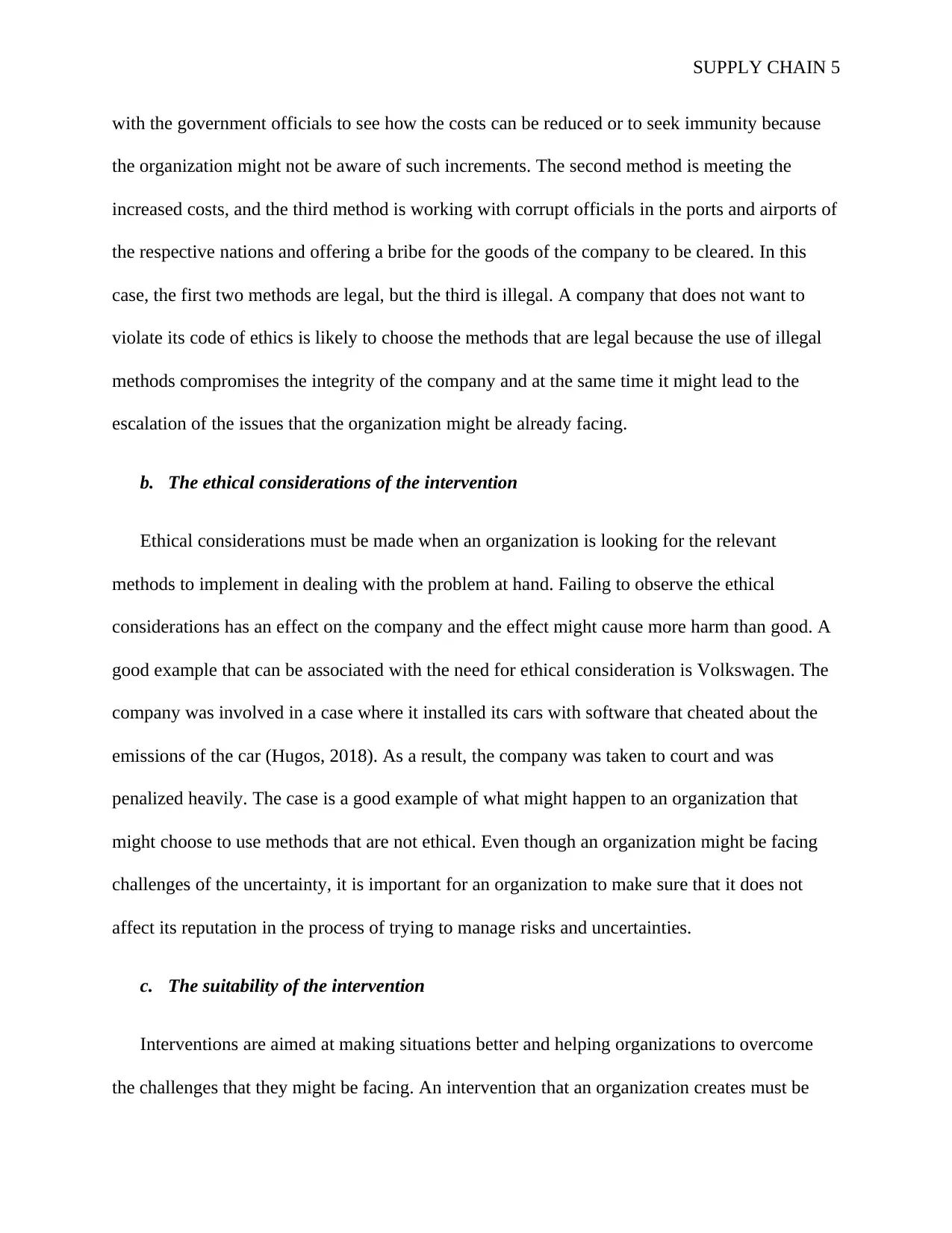
SUPPLY CHAIN 5
with the government officials to see how the costs can be reduced or to seek immunity because
the organization might not be aware of such increments. The second method is meeting the
increased costs, and the third method is working with corrupt officials in the ports and airports of
the respective nations and offering a bribe for the goods of the company to be cleared. In this
case, the first two methods are legal, but the third is illegal. A company that does not want to
violate its code of ethics is likely to choose the methods that are legal because the use of illegal
methods compromises the integrity of the company and at the same time it might lead to the
escalation of the issues that the organization might be already facing.
b. The ethical considerations of the intervention
Ethical considerations must be made when an organization is looking for the relevant
methods to implement in dealing with the problem at hand. Failing to observe the ethical
considerations has an effect on the company and the effect might cause more harm than good. A
good example that can be associated with the need for ethical consideration is Volkswagen. The
company was involved in a case where it installed its cars with software that cheated about the
emissions of the car (Hugos, 2018). As a result, the company was taken to court and was
penalized heavily. The case is a good example of what might happen to an organization that
might choose to use methods that are not ethical. Even though an organization might be facing
challenges of the uncertainty, it is important for an organization to make sure that it does not
affect its reputation in the process of trying to manage risks and uncertainties.
c. The suitability of the intervention
Interventions are aimed at making situations better and helping organizations to overcome
the challenges that they might be facing. An intervention that an organization creates must be
with the government officials to see how the costs can be reduced or to seek immunity because
the organization might not be aware of such increments. The second method is meeting the
increased costs, and the third method is working with corrupt officials in the ports and airports of
the respective nations and offering a bribe for the goods of the company to be cleared. In this
case, the first two methods are legal, but the third is illegal. A company that does not want to
violate its code of ethics is likely to choose the methods that are legal because the use of illegal
methods compromises the integrity of the company and at the same time it might lead to the
escalation of the issues that the organization might be already facing.
b. The ethical considerations of the intervention
Ethical considerations must be made when an organization is looking for the relevant
methods to implement in dealing with the problem at hand. Failing to observe the ethical
considerations has an effect on the company and the effect might cause more harm than good. A
good example that can be associated with the need for ethical consideration is Volkswagen. The
company was involved in a case where it installed its cars with software that cheated about the
emissions of the car (Hugos, 2018). As a result, the company was taken to court and was
penalized heavily. The case is a good example of what might happen to an organization that
might choose to use methods that are not ethical. Even though an organization might be facing
challenges of the uncertainty, it is important for an organization to make sure that it does not
affect its reputation in the process of trying to manage risks and uncertainties.
c. The suitability of the intervention
Interventions are aimed at making situations better and helping organizations to overcome
the challenges that they might be facing. An intervention that an organization creates must be
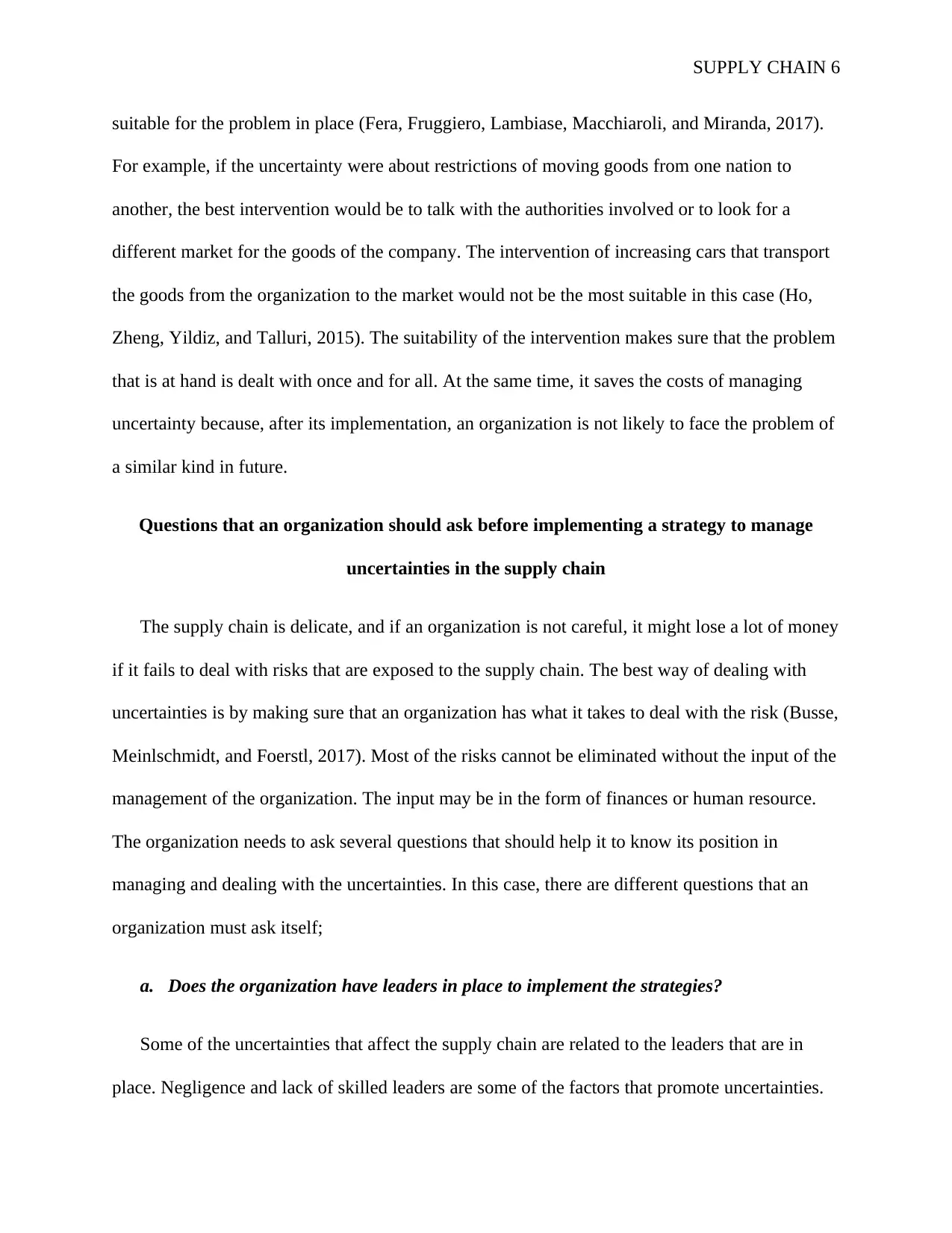
SUPPLY CHAIN 6
suitable for the problem in place (Fera, Fruggiero, Lambiase, Macchiaroli, and Miranda, 2017).
For example, if the uncertainty were about restrictions of moving goods from one nation to
another, the best intervention would be to talk with the authorities involved or to look for a
different market for the goods of the company. The intervention of increasing cars that transport
the goods from the organization to the market would not be the most suitable in this case (Ho,
Zheng, Yildiz, and Talluri, 2015). The suitability of the intervention makes sure that the problem
that is at hand is dealt with once and for all. At the same time, it saves the costs of managing
uncertainty because, after its implementation, an organization is not likely to face the problem of
a similar kind in future.
Questions that an organization should ask before implementing a strategy to manage
uncertainties in the supply chain
The supply chain is delicate, and if an organization is not careful, it might lose a lot of money
if it fails to deal with risks that are exposed to the supply chain. The best way of dealing with
uncertainties is by making sure that an organization has what it takes to deal with the risk (Busse,
Meinlschmidt, and Foerstl, 2017). Most of the risks cannot be eliminated without the input of the
management of the organization. The input may be in the form of finances or human resource.
The organization needs to ask several questions that should help it to know its position in
managing and dealing with the uncertainties. In this case, there are different questions that an
organization must ask itself;
a. Does the organization have leaders in place to implement the strategies?
Some of the uncertainties that affect the supply chain are related to the leaders that are in
place. Negligence and lack of skilled leaders are some of the factors that promote uncertainties.
suitable for the problem in place (Fera, Fruggiero, Lambiase, Macchiaroli, and Miranda, 2017).
For example, if the uncertainty were about restrictions of moving goods from one nation to
another, the best intervention would be to talk with the authorities involved or to look for a
different market for the goods of the company. The intervention of increasing cars that transport
the goods from the organization to the market would not be the most suitable in this case (Ho,
Zheng, Yildiz, and Talluri, 2015). The suitability of the intervention makes sure that the problem
that is at hand is dealt with once and for all. At the same time, it saves the costs of managing
uncertainty because, after its implementation, an organization is not likely to face the problem of
a similar kind in future.
Questions that an organization should ask before implementing a strategy to manage
uncertainties in the supply chain
The supply chain is delicate, and if an organization is not careful, it might lose a lot of money
if it fails to deal with risks that are exposed to the supply chain. The best way of dealing with
uncertainties is by making sure that an organization has what it takes to deal with the risk (Busse,
Meinlschmidt, and Foerstl, 2017). Most of the risks cannot be eliminated without the input of the
management of the organization. The input may be in the form of finances or human resource.
The organization needs to ask several questions that should help it to know its position in
managing and dealing with the uncertainties. In this case, there are different questions that an
organization must ask itself;
a. Does the organization have leaders in place to implement the strategies?
Some of the uncertainties that affect the supply chain are related to the leaders that are in
place. Negligence and lack of skilled leaders are some of the factors that promote uncertainties.
⊘ This is a preview!⊘
Do you want full access?
Subscribe today to unlock all pages.

Trusted by 1+ million students worldwide
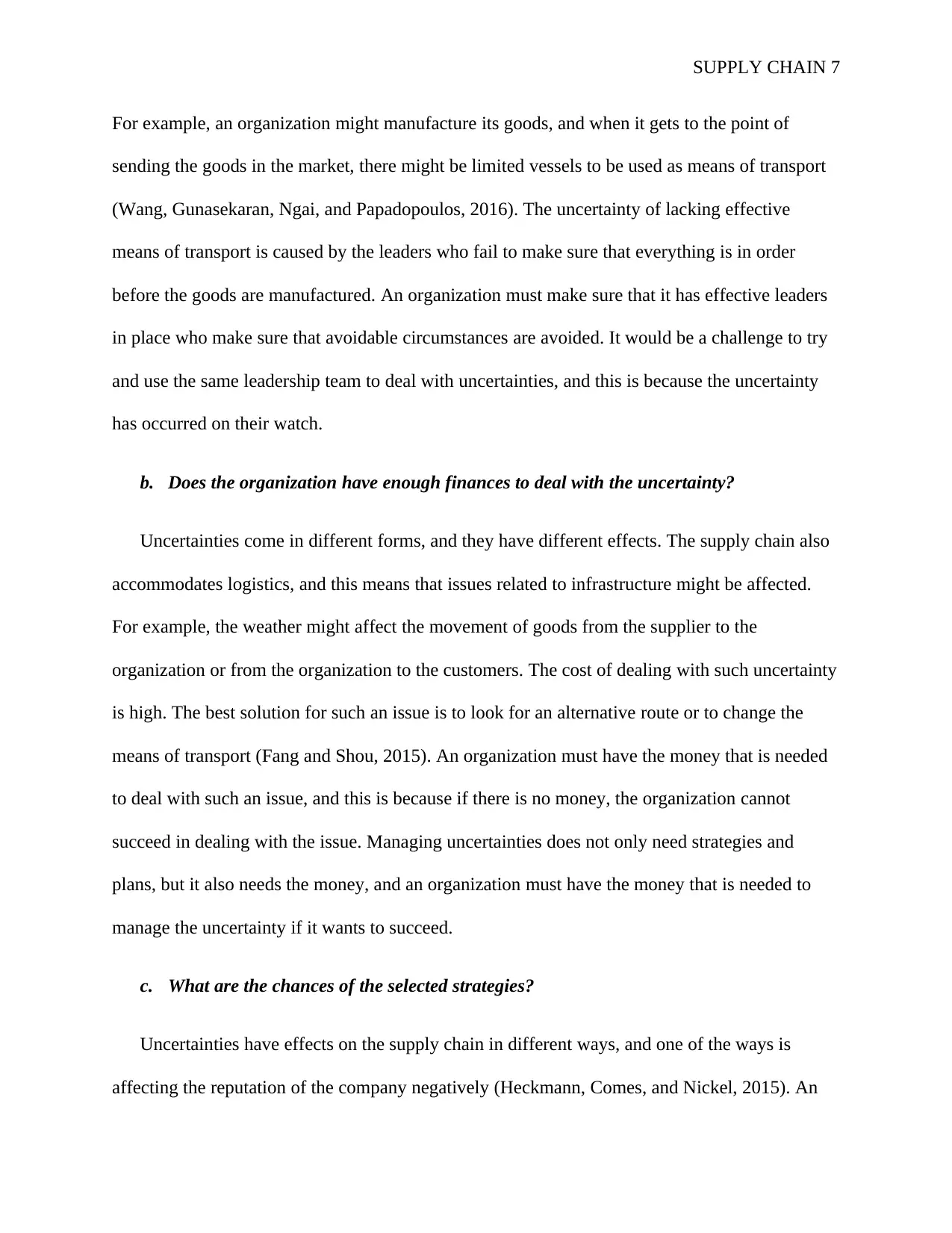
SUPPLY CHAIN 7
For example, an organization might manufacture its goods, and when it gets to the point of
sending the goods in the market, there might be limited vessels to be used as means of transport
(Wang, Gunasekaran, Ngai, and Papadopoulos, 2016). The uncertainty of lacking effective
means of transport is caused by the leaders who fail to make sure that everything is in order
before the goods are manufactured. An organization must make sure that it has effective leaders
in place who make sure that avoidable circumstances are avoided. It would be a challenge to try
and use the same leadership team to deal with uncertainties, and this is because the uncertainty
has occurred on their watch.
b. Does the organization have enough finances to deal with the uncertainty?
Uncertainties come in different forms, and they have different effects. The supply chain also
accommodates logistics, and this means that issues related to infrastructure might be affected.
For example, the weather might affect the movement of goods from the supplier to the
organization or from the organization to the customers. The cost of dealing with such uncertainty
is high. The best solution for such an issue is to look for an alternative route or to change the
means of transport (Fang and Shou, 2015). An organization must have the money that is needed
to deal with such an issue, and this is because if there is no money, the organization cannot
succeed in dealing with the issue. Managing uncertainties does not only need strategies and
plans, but it also needs the money, and an organization must have the money that is needed to
manage the uncertainty if it wants to succeed.
c. What are the chances of the selected strategies?
Uncertainties have effects on the supply chain in different ways, and one of the ways is
affecting the reputation of the company negatively (Heckmann, Comes, and Nickel, 2015). An
For example, an organization might manufacture its goods, and when it gets to the point of
sending the goods in the market, there might be limited vessels to be used as means of transport
(Wang, Gunasekaran, Ngai, and Papadopoulos, 2016). The uncertainty of lacking effective
means of transport is caused by the leaders who fail to make sure that everything is in order
before the goods are manufactured. An organization must make sure that it has effective leaders
in place who make sure that avoidable circumstances are avoided. It would be a challenge to try
and use the same leadership team to deal with uncertainties, and this is because the uncertainty
has occurred on their watch.
b. Does the organization have enough finances to deal with the uncertainty?
Uncertainties come in different forms, and they have different effects. The supply chain also
accommodates logistics, and this means that issues related to infrastructure might be affected.
For example, the weather might affect the movement of goods from the supplier to the
organization or from the organization to the customers. The cost of dealing with such uncertainty
is high. The best solution for such an issue is to look for an alternative route or to change the
means of transport (Fang and Shou, 2015). An organization must have the money that is needed
to deal with such an issue, and this is because if there is no money, the organization cannot
succeed in dealing with the issue. Managing uncertainties does not only need strategies and
plans, but it also needs the money, and an organization must have the money that is needed to
manage the uncertainty if it wants to succeed.
c. What are the chances of the selected strategies?
Uncertainties have effects on the supply chain in different ways, and one of the ways is
affecting the reputation of the company negatively (Heckmann, Comes, and Nickel, 2015). An
Paraphrase This Document
Need a fresh take? Get an instant paraphrase of this document with our AI Paraphraser
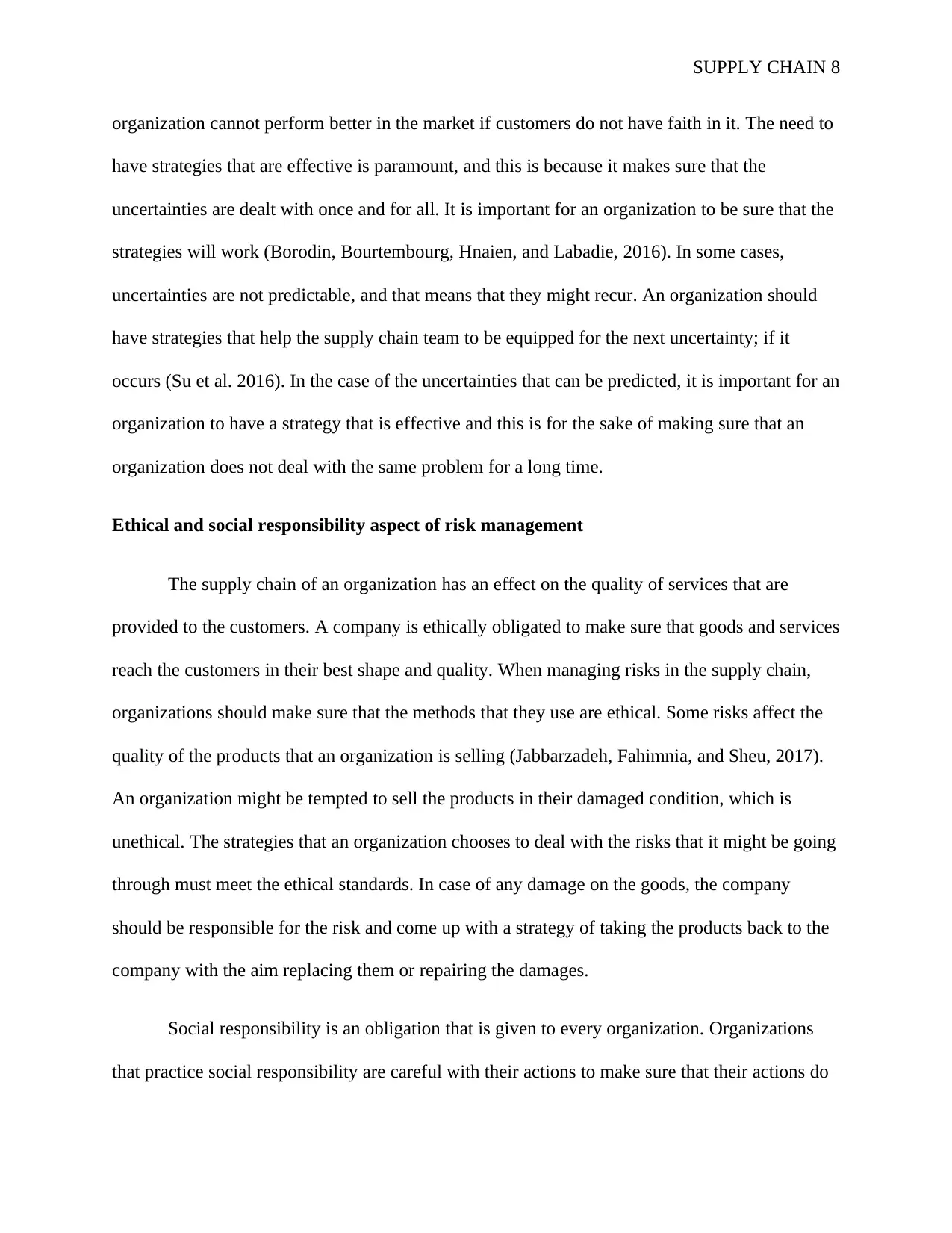
SUPPLY CHAIN 8
organization cannot perform better in the market if customers do not have faith in it. The need to
have strategies that are effective is paramount, and this is because it makes sure that the
uncertainties are dealt with once and for all. It is important for an organization to be sure that the
strategies will work (Borodin, Bourtembourg, Hnaien, and Labadie, 2016). In some cases,
uncertainties are not predictable, and that means that they might recur. An organization should
have strategies that help the supply chain team to be equipped for the next uncertainty; if it
occurs (Su et al. 2016). In the case of the uncertainties that can be predicted, it is important for an
organization to have a strategy that is effective and this is for the sake of making sure that an
organization does not deal with the same problem for a long time.
Ethical and social responsibility aspect of risk management
The supply chain of an organization has an effect on the quality of services that are
provided to the customers. A company is ethically obligated to make sure that goods and services
reach the customers in their best shape and quality. When managing risks in the supply chain,
organizations should make sure that the methods that they use are ethical. Some risks affect the
quality of the products that an organization is selling (Jabbarzadeh, Fahimnia, and Sheu, 2017).
An organization might be tempted to sell the products in their damaged condition, which is
unethical. The strategies that an organization chooses to deal with the risks that it might be going
through must meet the ethical standards. In case of any damage on the goods, the company
should be responsible for the risk and come up with a strategy of taking the products back to the
company with the aim replacing them or repairing the damages.
Social responsibility is an obligation that is given to every organization. Organizations
that practice social responsibility are careful with their actions to make sure that their actions do
organization cannot perform better in the market if customers do not have faith in it. The need to
have strategies that are effective is paramount, and this is because it makes sure that the
uncertainties are dealt with once and for all. It is important for an organization to be sure that the
strategies will work (Borodin, Bourtembourg, Hnaien, and Labadie, 2016). In some cases,
uncertainties are not predictable, and that means that they might recur. An organization should
have strategies that help the supply chain team to be equipped for the next uncertainty; if it
occurs (Su et al. 2016). In the case of the uncertainties that can be predicted, it is important for an
organization to have a strategy that is effective and this is for the sake of making sure that an
organization does not deal with the same problem for a long time.
Ethical and social responsibility aspect of risk management
The supply chain of an organization has an effect on the quality of services that are
provided to the customers. A company is ethically obligated to make sure that goods and services
reach the customers in their best shape and quality. When managing risks in the supply chain,
organizations should make sure that the methods that they use are ethical. Some risks affect the
quality of the products that an organization is selling (Jabbarzadeh, Fahimnia, and Sheu, 2017).
An organization might be tempted to sell the products in their damaged condition, which is
unethical. The strategies that an organization chooses to deal with the risks that it might be going
through must meet the ethical standards. In case of any damage on the goods, the company
should be responsible for the risk and come up with a strategy of taking the products back to the
company with the aim replacing them or repairing the damages.
Social responsibility is an obligation that is given to every organization. Organizations
that practice social responsibility are careful with their actions to make sure that their actions do
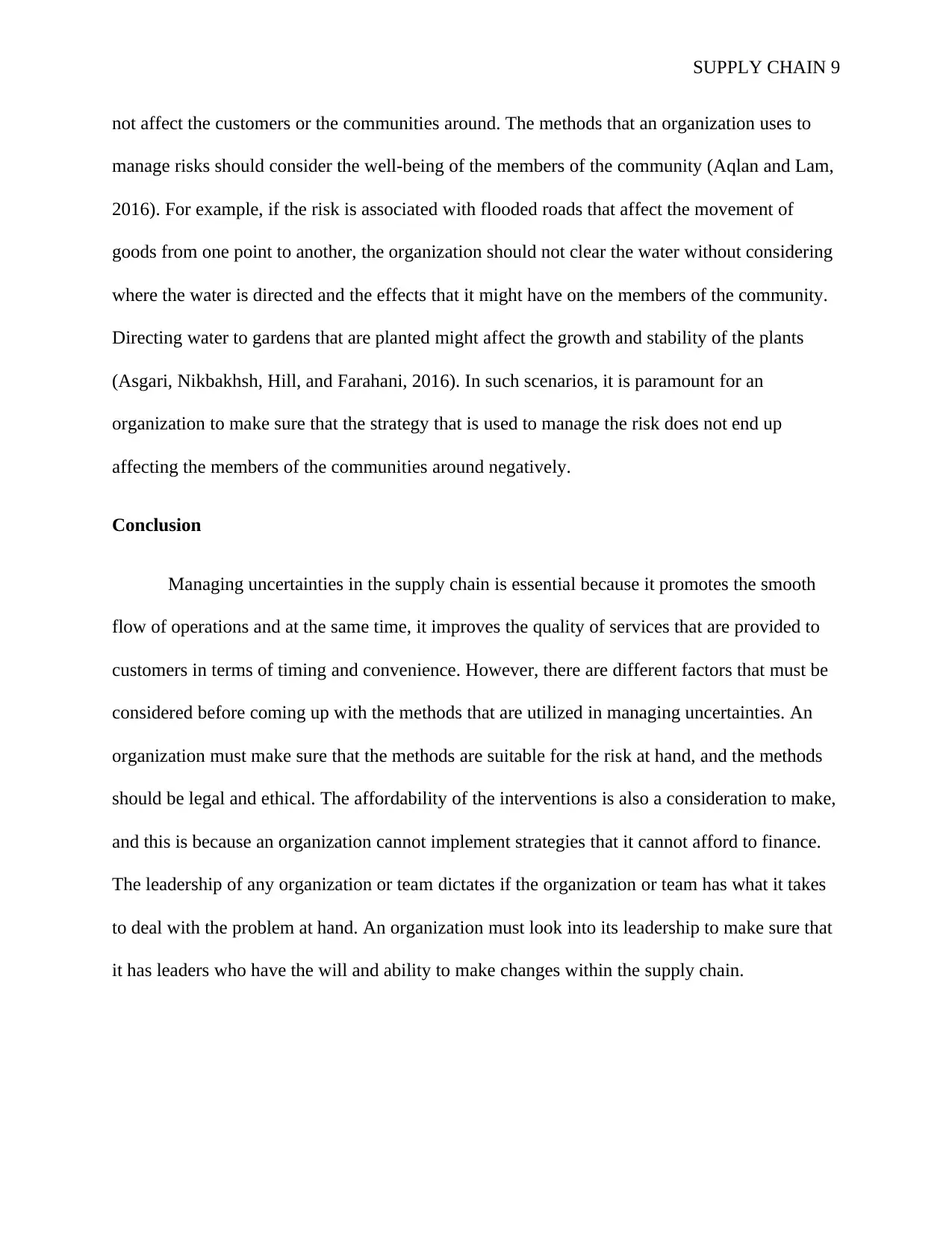
SUPPLY CHAIN 9
not affect the customers or the communities around. The methods that an organization uses to
manage risks should consider the well-being of the members of the community (Aqlan and Lam,
2016). For example, if the risk is associated with flooded roads that affect the movement of
goods from one point to another, the organization should not clear the water without considering
where the water is directed and the effects that it might have on the members of the community.
Directing water to gardens that are planted might affect the growth and stability of the plants
(Asgari, Nikbakhsh, Hill, and Farahani, 2016). In such scenarios, it is paramount for an
organization to make sure that the strategy that is used to manage the risk does not end up
affecting the members of the communities around negatively.
Conclusion
Managing uncertainties in the supply chain is essential because it promotes the smooth
flow of operations and at the same time, it improves the quality of services that are provided to
customers in terms of timing and convenience. However, there are different factors that must be
considered before coming up with the methods that are utilized in managing uncertainties. An
organization must make sure that the methods are suitable for the risk at hand, and the methods
should be legal and ethical. The affordability of the interventions is also a consideration to make,
and this is because an organization cannot implement strategies that it cannot afford to finance.
The leadership of any organization or team dictates if the organization or team has what it takes
to deal with the problem at hand. An organization must look into its leadership to make sure that
it has leaders who have the will and ability to make changes within the supply chain.
not affect the customers or the communities around. The methods that an organization uses to
manage risks should consider the well-being of the members of the community (Aqlan and Lam,
2016). For example, if the risk is associated with flooded roads that affect the movement of
goods from one point to another, the organization should not clear the water without considering
where the water is directed and the effects that it might have on the members of the community.
Directing water to gardens that are planted might affect the growth and stability of the plants
(Asgari, Nikbakhsh, Hill, and Farahani, 2016). In such scenarios, it is paramount for an
organization to make sure that the strategy that is used to manage the risk does not end up
affecting the members of the communities around negatively.
Conclusion
Managing uncertainties in the supply chain is essential because it promotes the smooth
flow of operations and at the same time, it improves the quality of services that are provided to
customers in terms of timing and convenience. However, there are different factors that must be
considered before coming up with the methods that are utilized in managing uncertainties. An
organization must make sure that the methods are suitable for the risk at hand, and the methods
should be legal and ethical. The affordability of the interventions is also a consideration to make,
and this is because an organization cannot implement strategies that it cannot afford to finance.
The leadership of any organization or team dictates if the organization or team has what it takes
to deal with the problem at hand. An organization must look into its leadership to make sure that
it has leaders who have the will and ability to make changes within the supply chain.
⊘ This is a preview!⊘
Do you want full access?
Subscribe today to unlock all pages.

Trusted by 1+ million students worldwide
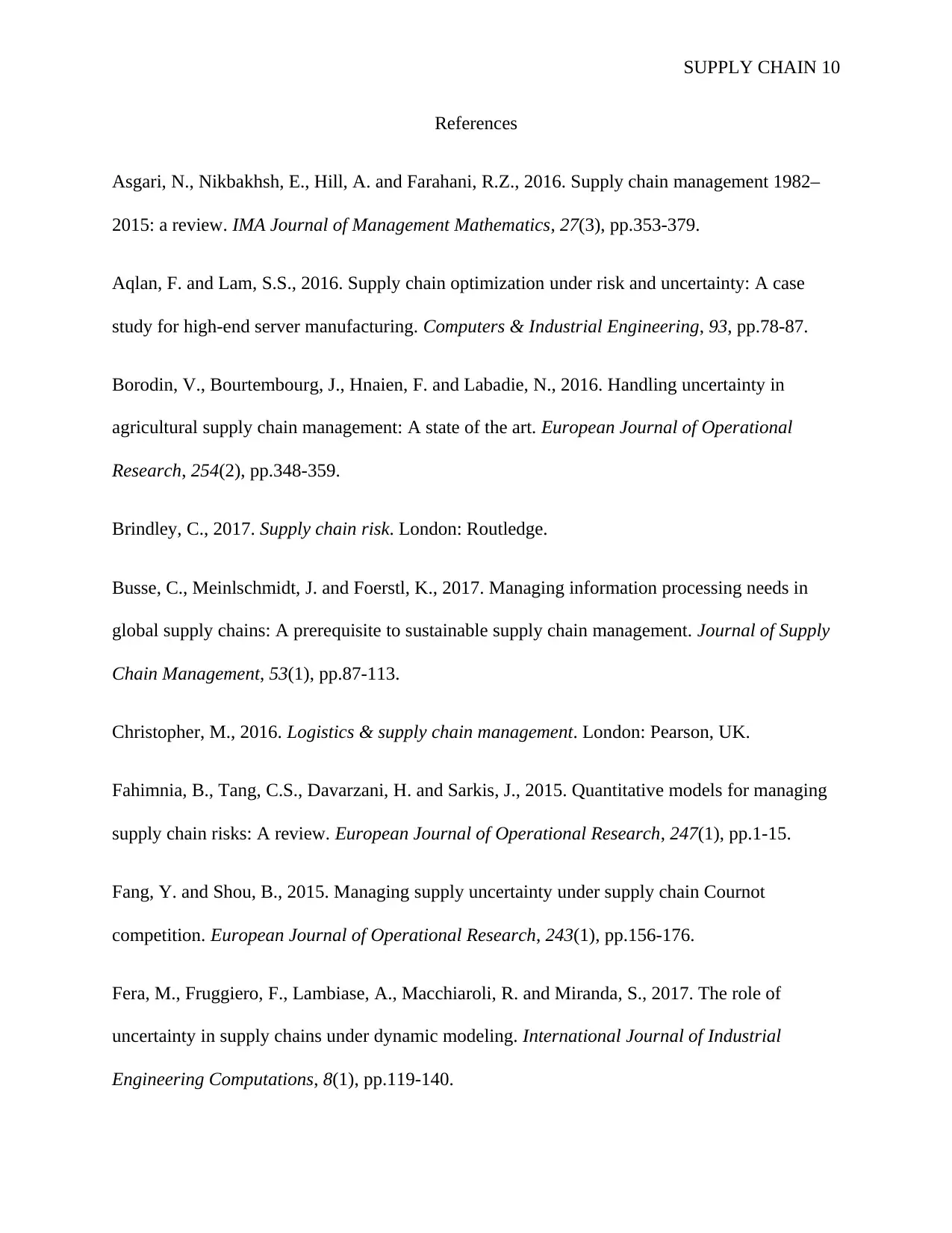
SUPPLY CHAIN 10
References
Asgari, N., Nikbakhsh, E., Hill, A. and Farahani, R.Z., 2016. Supply chain management 1982–
2015: a review. IMA Journal of Management Mathematics, 27(3), pp.353-379.
Aqlan, F. and Lam, S.S., 2016. Supply chain optimization under risk and uncertainty: A case
study for high-end server manufacturing. Computers & Industrial Engineering, 93, pp.78-87.
Borodin, V., Bourtembourg, J., Hnaien, F. and Labadie, N., 2016. Handling uncertainty in
agricultural supply chain management: A state of the art. European Journal of Operational
Research, 254(2), pp.348-359.
Brindley, C., 2017. Supply chain risk. London: Routledge.
Busse, C., Meinlschmidt, J. and Foerstl, K., 2017. Managing information processing needs in
global supply chains: A prerequisite to sustainable supply chain management. Journal of Supply
Chain Management, 53(1), pp.87-113.
Christopher, M., 2016. Logistics & supply chain management. London: Pearson, UK.
Fahimnia, B., Tang, C.S., Davarzani, H. and Sarkis, J., 2015. Quantitative models for managing
supply chain risks: A review. European Journal of Operational Research, 247(1), pp.1-15.
Fang, Y. and Shou, B., 2015. Managing supply uncertainty under supply chain Cournot
competition. European Journal of Operational Research, 243(1), pp.156-176.
Fera, M., Fruggiero, F., Lambiase, A., Macchiaroli, R. and Miranda, S., 2017. The role of
uncertainty in supply chains under dynamic modeling. International Journal of Industrial
Engineering Computations, 8(1), pp.119-140.
References
Asgari, N., Nikbakhsh, E., Hill, A. and Farahani, R.Z., 2016. Supply chain management 1982–
2015: a review. IMA Journal of Management Mathematics, 27(3), pp.353-379.
Aqlan, F. and Lam, S.S., 2016. Supply chain optimization under risk and uncertainty: A case
study for high-end server manufacturing. Computers & Industrial Engineering, 93, pp.78-87.
Borodin, V., Bourtembourg, J., Hnaien, F. and Labadie, N., 2016. Handling uncertainty in
agricultural supply chain management: A state of the art. European Journal of Operational
Research, 254(2), pp.348-359.
Brindley, C., 2017. Supply chain risk. London: Routledge.
Busse, C., Meinlschmidt, J. and Foerstl, K., 2017. Managing information processing needs in
global supply chains: A prerequisite to sustainable supply chain management. Journal of Supply
Chain Management, 53(1), pp.87-113.
Christopher, M., 2016. Logistics & supply chain management. London: Pearson, UK.
Fahimnia, B., Tang, C.S., Davarzani, H. and Sarkis, J., 2015. Quantitative models for managing
supply chain risks: A review. European Journal of Operational Research, 247(1), pp.1-15.
Fang, Y. and Shou, B., 2015. Managing supply uncertainty under supply chain Cournot
competition. European Journal of Operational Research, 243(1), pp.156-176.
Fera, M., Fruggiero, F., Lambiase, A., Macchiaroli, R. and Miranda, S., 2017. The role of
uncertainty in supply chains under dynamic modeling. International Journal of Industrial
Engineering Computations, 8(1), pp.119-140.
Paraphrase This Document
Need a fresh take? Get an instant paraphrase of this document with our AI Paraphraser
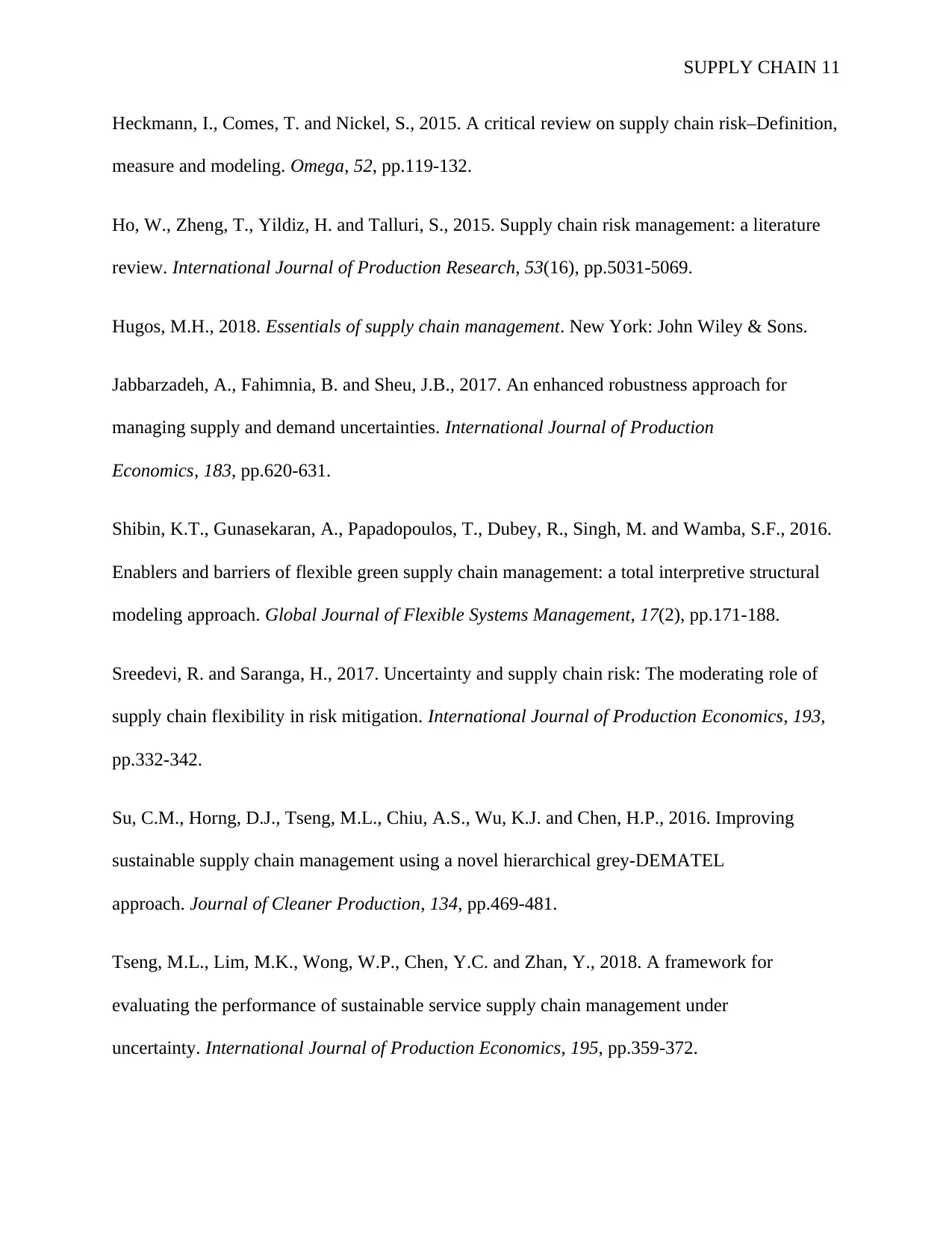
SUPPLY CHAIN 11
Heckmann, I., Comes, T. and Nickel, S., 2015. A critical review on supply chain risk–Definition,
measure and modeling. Omega, 52, pp.119-132.
Ho, W., Zheng, T., Yildiz, H. and Talluri, S., 2015. Supply chain risk management: a literature
review. International Journal of Production Research, 53(16), pp.5031-5069.
Hugos, M.H., 2018. Essentials of supply chain management. New York: John Wiley & Sons.
Jabbarzadeh, A., Fahimnia, B. and Sheu, J.B., 2017. An enhanced robustness approach for
managing supply and demand uncertainties. International Journal of Production
Economics, 183, pp.620-631.
Shibin, K.T., Gunasekaran, A., Papadopoulos, T., Dubey, R., Singh, M. and Wamba, S.F., 2016.
Enablers and barriers of flexible green supply chain management: a total interpretive structural
modeling approach. Global Journal of Flexible Systems Management, 17(2), pp.171-188.
Sreedevi, R. and Saranga, H., 2017. Uncertainty and supply chain risk: The moderating role of
supply chain flexibility in risk mitigation. International Journal of Production Economics, 193,
pp.332-342.
Su, C.M., Horng, D.J., Tseng, M.L., Chiu, A.S., Wu, K.J. and Chen, H.P., 2016. Improving
sustainable supply chain management using a novel hierarchical grey-DEMATEL
approach. Journal of Cleaner Production, 134, pp.469-481.
Tseng, M.L., Lim, M.K., Wong, W.P., Chen, Y.C. and Zhan, Y., 2018. A framework for
evaluating the performance of sustainable service supply chain management under
uncertainty. International Journal of Production Economics, 195, pp.359-372.
Heckmann, I., Comes, T. and Nickel, S., 2015. A critical review on supply chain risk–Definition,
measure and modeling. Omega, 52, pp.119-132.
Ho, W., Zheng, T., Yildiz, H. and Talluri, S., 2015. Supply chain risk management: a literature
review. International Journal of Production Research, 53(16), pp.5031-5069.
Hugos, M.H., 2018. Essentials of supply chain management. New York: John Wiley & Sons.
Jabbarzadeh, A., Fahimnia, B. and Sheu, J.B., 2017. An enhanced robustness approach for
managing supply and demand uncertainties. International Journal of Production
Economics, 183, pp.620-631.
Shibin, K.T., Gunasekaran, A., Papadopoulos, T., Dubey, R., Singh, M. and Wamba, S.F., 2016.
Enablers and barriers of flexible green supply chain management: a total interpretive structural
modeling approach. Global Journal of Flexible Systems Management, 17(2), pp.171-188.
Sreedevi, R. and Saranga, H., 2017. Uncertainty and supply chain risk: The moderating role of
supply chain flexibility in risk mitigation. International Journal of Production Economics, 193,
pp.332-342.
Su, C.M., Horng, D.J., Tseng, M.L., Chiu, A.S., Wu, K.J. and Chen, H.P., 2016. Improving
sustainable supply chain management using a novel hierarchical grey-DEMATEL
approach. Journal of Cleaner Production, 134, pp.469-481.
Tseng, M.L., Lim, M.K., Wong, W.P., Chen, Y.C. and Zhan, Y., 2018. A framework for
evaluating the performance of sustainable service supply chain management under
uncertainty. International Journal of Production Economics, 195, pp.359-372.
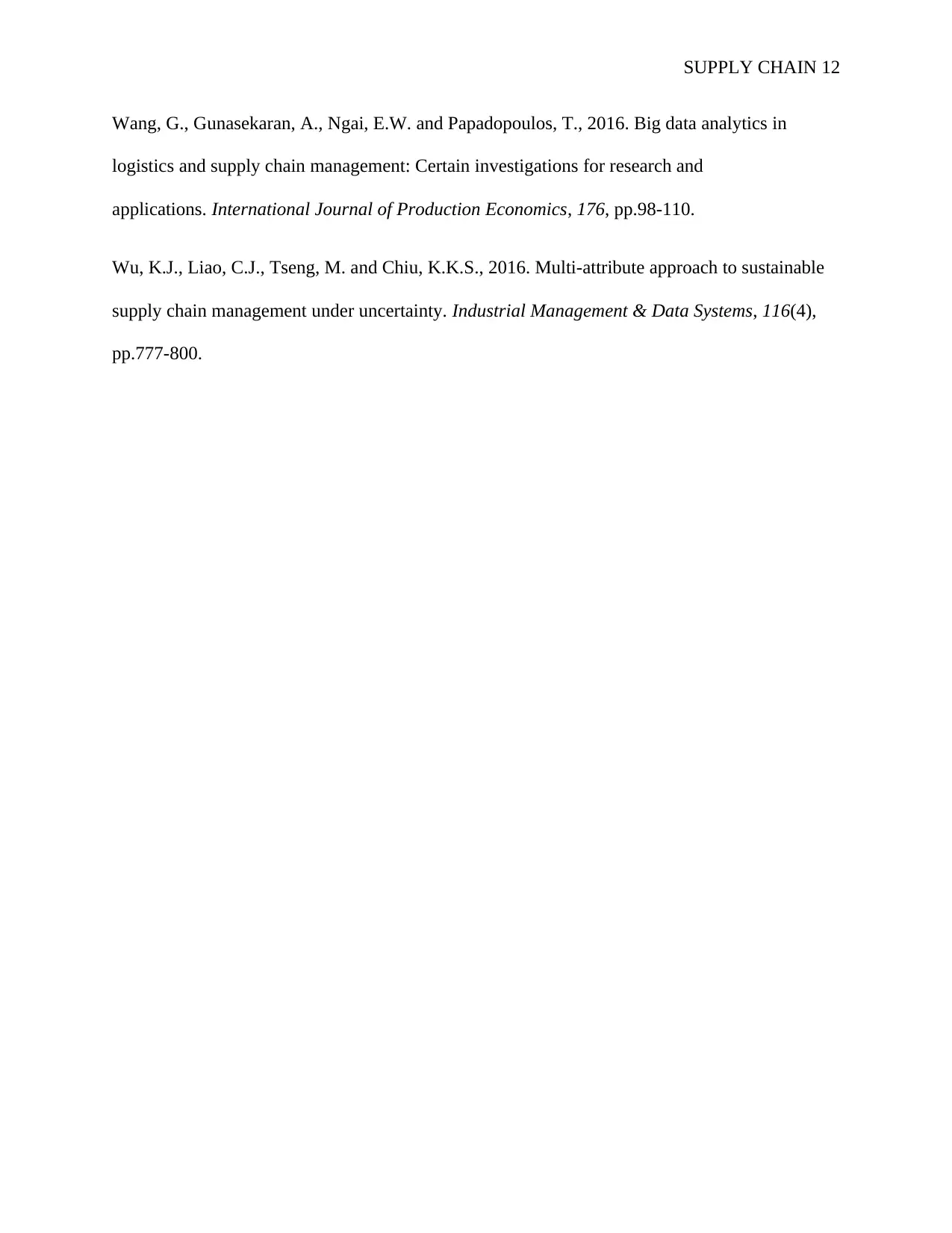
SUPPLY CHAIN 12
Wang, G., Gunasekaran, A., Ngai, E.W. and Papadopoulos, T., 2016. Big data analytics in
logistics and supply chain management: Certain investigations for research and
applications. International Journal of Production Economics, 176, pp.98-110.
Wu, K.J., Liao, C.J., Tseng, M. and Chiu, K.K.S., 2016. Multi-attribute approach to sustainable
supply chain management under uncertainty. Industrial Management & Data Systems, 116(4),
pp.777-800.
Wang, G., Gunasekaran, A., Ngai, E.W. and Papadopoulos, T., 2016. Big data analytics in
logistics and supply chain management: Certain investigations for research and
applications. International Journal of Production Economics, 176, pp.98-110.
Wu, K.J., Liao, C.J., Tseng, M. and Chiu, K.K.S., 2016. Multi-attribute approach to sustainable
supply chain management under uncertainty. Industrial Management & Data Systems, 116(4),
pp.777-800.
⊘ This is a preview!⊘
Do you want full access?
Subscribe today to unlock all pages.

Trusted by 1+ million students worldwide
1 out of 12
Related Documents
Your All-in-One AI-Powered Toolkit for Academic Success.
+13062052269
info@desklib.com
Available 24*7 on WhatsApp / Email
![[object Object]](/_next/static/media/star-bottom.7253800d.svg)
Unlock your academic potential
Copyright © 2020–2025 A2Z Services. All Rights Reserved. Developed and managed by ZUCOL.




